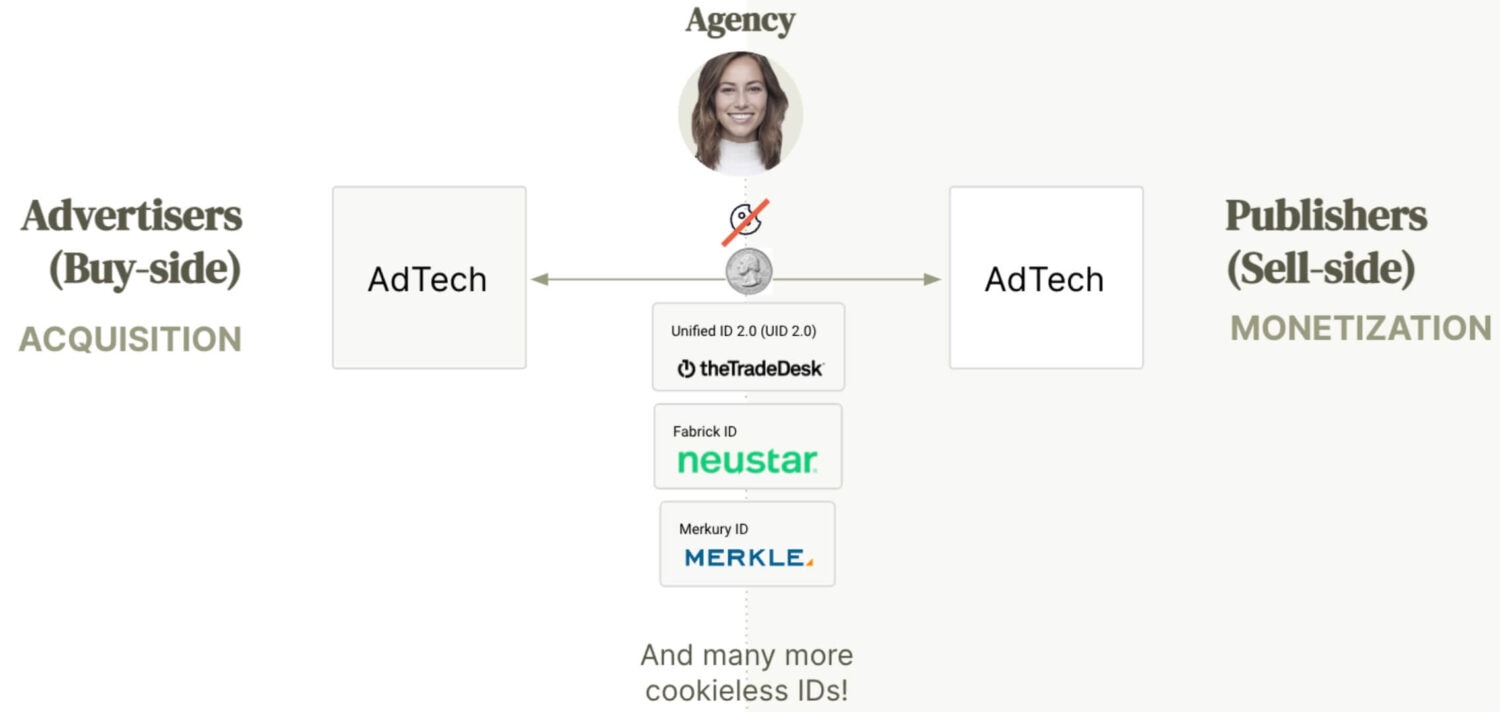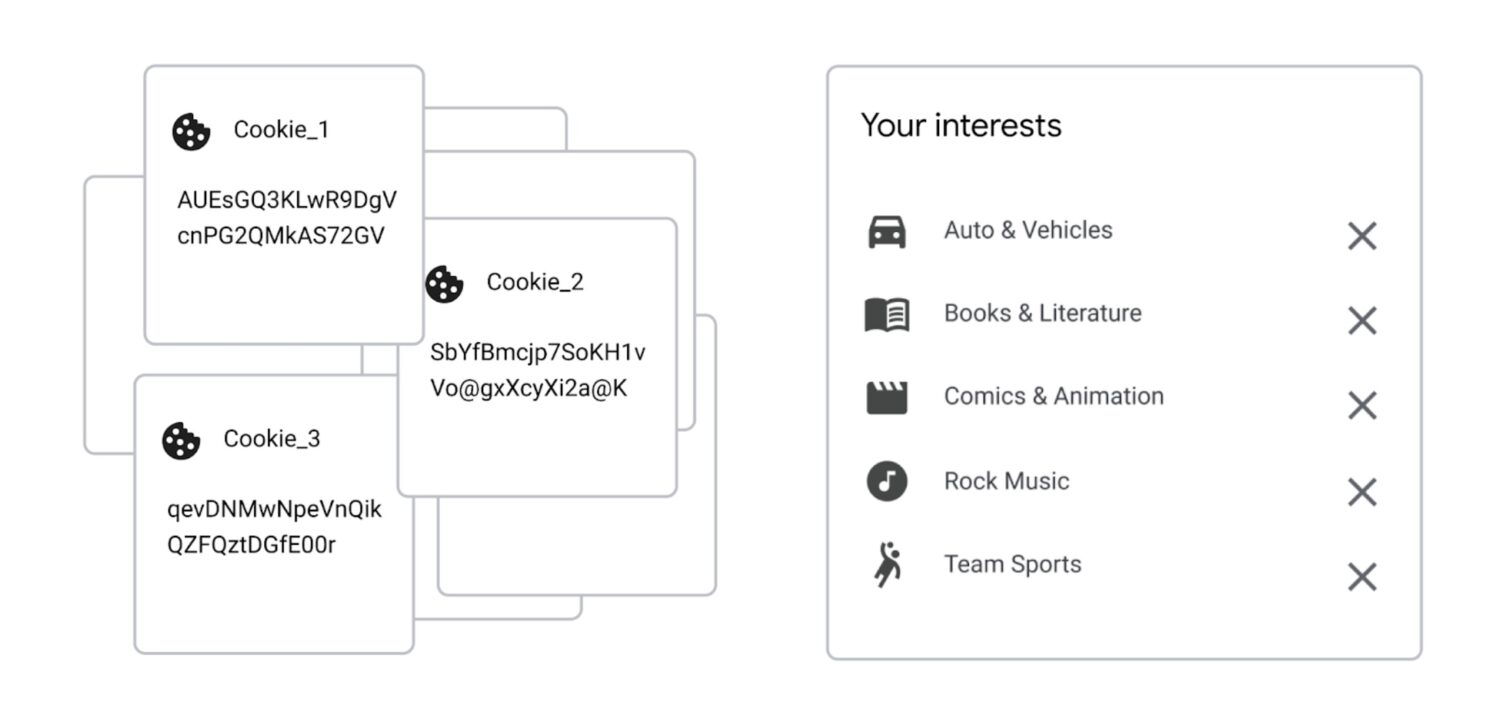The Future of Targeted Advertising: Identity or Not?

Maybe you didn’t like third-party cookies, but everybody was using them: publishers, advertisers, agencies. They were everywhere. They were cheap. Now, they are (almost) gone. Among the most impacted use cases: targeted advertising.
How can brands keep targeting effectively without blowing their customer acquisition cost (CAC) in a world without third-party cookies?
How can publishers maximize their inventory monetization without depending on third-party cookies?
This blog post will walk you through the three dominant alternatives to target users on digital properties.
The Future of Targeted Advertising: Identity or Not?

| Targeting via: | Cookieless ID | Cohort | Contextual |
|---|---|---|---|
| Description | Identifier meant to replace third-party cookies and maintain the ability to target users at the individual level. | Grouping of users sharing similar traits without allowing to separate them and identify them individually. | Targeting based on the content being viewed as opposed to user information. |
| Identity Level What identity is used for targeting | Individual | Cohort | None |
| Solution Examples | UID2 Fabrick ID (Neustar) Merkury ID (Merkle) Ramp ID (Liveramp) | Google Topics Yelp Audiences | GumGum AdButler |
| Benefits | Closest alternative to third-party cookies, enabling individual level targeting. | Alternative which doesn’t rely on any individual identity. | Not relying on any identity, no user consent required. |
| Challenges | Scrutiny from regulators who are looking to prevent getting back to the same situation which led to deprecating third-party cookies. | Performance is unclear as this mostly consists of new solutions being developed ; Good taxonomy is critical. | Performance can be questionable ; high dependency on content creation and taxonomy. |
| Recommendations | To use when looking for granular targeting with the ability to access addressable data. | To test early as individual targeting future is unclear and cost might keep increasing. | To prioritize when none of the alternatives are possible. |
Cookieless ID — Maintain Individual Targeting Capabilities
As soon as Google announced Chrome’s third-party cookie deprecation, traditional adtech vendors started to announce alternative identity solutions. While the name can be misleading, these solutions are often referred to as cookieless IDs.
The promise of these solutions is to provide a new currency allowing transactions between advertisers and publishers.
A way to think about it is reverting history in Europe:
- Third-party cookies were like euros (€), accepted in most countries but not universal — England, would not transact using euros. Connected TV or Mobile Apps don’t know cookies.
- If euros were to disappear, you could imagine each country trying to define which (new) currency to adopt. Create their own? Find what other countries are doing and adopt the same currency selected by countries you have high levels of import/export transactions with?

No consensus across everybody can be found so, instead, we will see a fragmentation within the identity space. Some cookieless IDs will have more adoptions than others. Luckily, it’s not exactly like a country currency and organizations will be able to adopt more than one cookieless identity solution.
Why would organizations be reluctant to adopt these cookieless IDs? They are scrutinized by regulators, worried of seeing the same story as with third-party cookies repeat itself. After all, the idea is literally trying to replace an identifier with another one to keep targeting at the individual level.
We also expect organizations to look closely at the cost for these solutions, as these won’t come cheap to adopt.
When evaluating these solutions for targeted advertising efforts, you’ll find two different approaches:
- Probabilistic: Vendors leveraging accessible anonymous signals to identify users. It will often involve IP address, user agent and other browser information. Who knows how long some of these signals will remain accessible, and how efficient are these probabilistic user identification. Neustar with its Fabrick ID is an example of a probabilistic solution.
- Deterministic: Vendors who are focusing on pseudonymous IDs, meaning IDs generated from an authenticated PII information, such as an email address or phone number. It does require prior authentication by the user on the advertiser’s site in order to gain access to such ID. The Trade Desk’s solution here, with the UID2, gained momentum on the market.
Addressability and interoperability will be key to adoption and growth of the solutions.
Cohort — Google’s Privacy-Safe Targeting Alternative
When Google initially announced the deprecation of third-party cookies from Chrome, they had to provide an alternative solution to keep enabling targeting and more without reliance on third-party cookies. Privacy Sandbox is Google’s regrouping of all these new proposals, or experimentations could we say.
The Federated Learning of Cohorts — known as FLoC — was the first proposal where Google would group users from the web into cohorts which can then be targeted. And you might already know this, but FLoC was a flop. A few tested the waters with very advanced testing of FLoC. Many voices raised concerns, mostly in Europe. FLoC is now gone.
But the concept of cohort is still present in a different form with Google’s newest proposal: Topics. The idea is to group users based on shared interests deducted from website visits.

Image Credits: Google
There are concerns about the solution and, after the challenges from FLoC, fewer organizations have been willing to put effort into testing the Topics proposal.
But the concept of cohort does not have to be limited to Google’s solution — which would not solve for other browsers such as Safari, where third-party cookies have already been deprecated for some time.
Publishers could be leveraging their first-party data to define audiences — I mean, cohorts — which could be purchased and targeted by advertisers (read about The Washington Post’s story here). But you can quickly see the scalability challenge if you are looking to work with multiple publishers: how do you facilitate the understanding of a cohort definition and content?
This is certainly the reason that led iab to start an audience taxonomy proposal. The market has not widely adopted this standardization attempt as of summer 2023, but consistency across publishers would certainly accelerate the adoption of cohort-based targeting.
Contextual — The Comeback for Non-identity Based Targeted Advertising
No identity? No problem. The idea of contextual advertising is not new, it actually existed before the reign of individual targeting via third-party cookies. The contextual approach represents the targeting based on the solely content being viewed.
A retailer selling sports jerseys could find interest in targeting users reading sports news content, and there is enough frequency of this content being published to find places to advertise.
But it might be a different story for a CPG brand selling toilet paper…
Contextual targeting is highly controversial. Some will claim that technology evolved and contextual is not what it was at the birth of advertising. Others — as pointed out by a McKinsey report — indicate that “contextual advertising rarely meets campaigns’ viewership goals.”
Its future is safe due to the absence of any identity dependence, but contextual advertising can be complex to manage for publishers, forcing a flow of content publication and — as for cohort-based targeting — taxonomy plays a critical role to facilitate transactions with advertisers.
Advertisers will likely find cheaper inventory and contextual inventory from traditional publishers who lack first-party data, while premium publishers who spent the last few years building their authenticated and consented customer database will focus on more qualitative individual or cohort-based targeting options.
Testing Early and Often is the Key to Success in Targeted Advertising
One thing is certain: third-party cookies are going away (eventually). No single solutions will replace them. And no single alternative will fit everybody’s needs in every scenario.
You need to start somewhere, meaning explore a cookieless ID, cohort or contextual based targeting. But the reality is: the world is evolving, constantly. The targeting solutions we discussed are at different maturity levels, different costs, and will drive different performances. Your long-term success will depend on your ability to test, test, and test again.

ActionIQ helped Bloomberg reduce their customer acquisition costs by 76% in just a few months. Contact us and learn more about how we support targeted advertising and many more use cases for enterprise organizations, advertisers and publishers.





